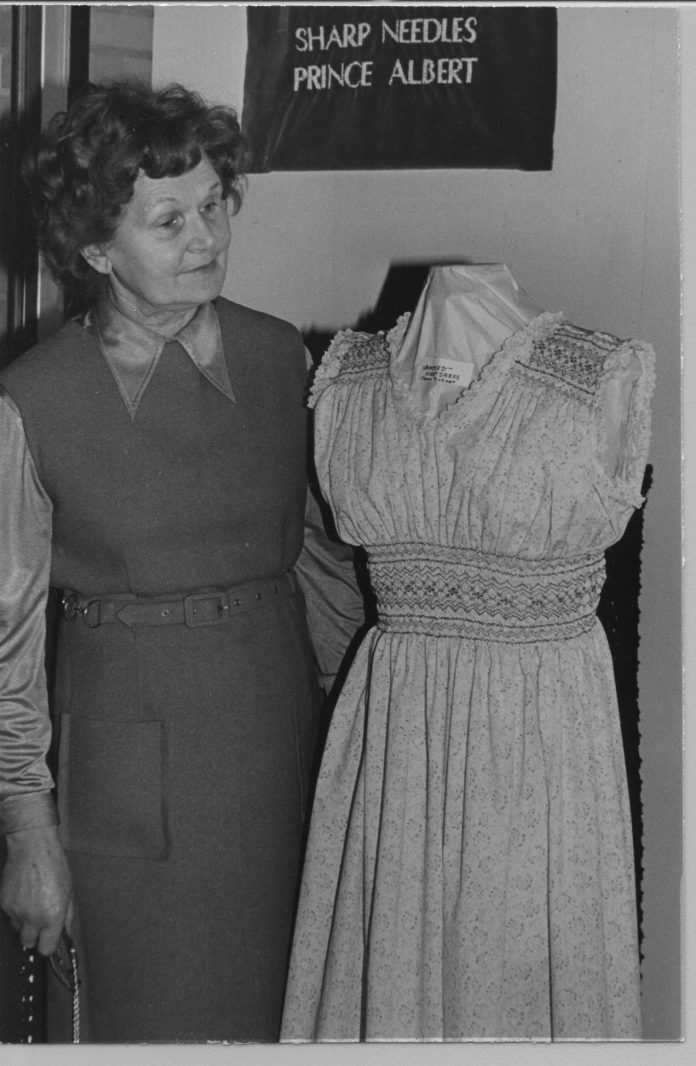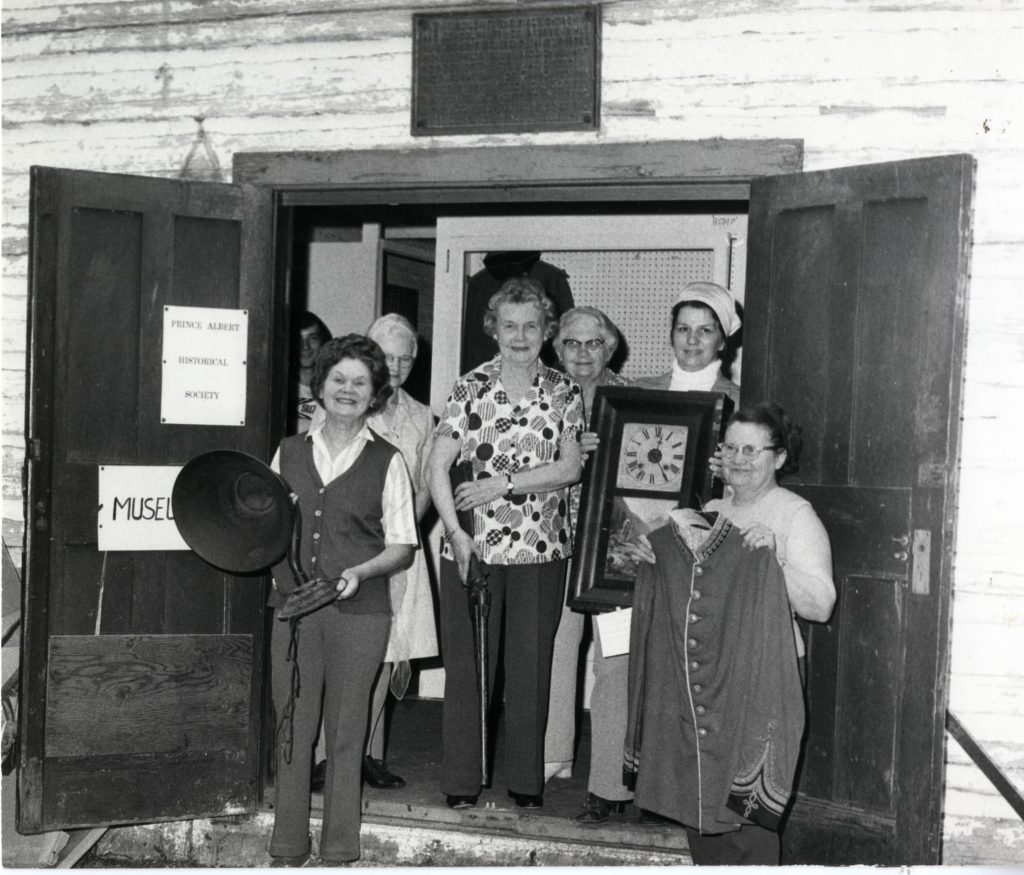
She could have been a character in a British mystery, one of Agatha Christie’s cozies, perhaps a neighbour of Miss Marple. Except when we knew her, she didn’t live in the south of England. She lived in Prince Albert.
Margaret Olwyn Kerr, known to most of us as Peggy, or Peg, was born in the English County of Buckinghamshire in the latter years of the First World War. As a young child, she moved with her family to the village of Box in the neighbouring County of Wiltshire.
Her father, Herbert Newman, was from Norwich. Her mother, Louise, had Welsh roots. Herbert was a gardener, which accounts for Peggy’s great affection for flowers and other plants. Louise bred poultry and raised prize pigs. It would appear that Peggy inherited her mother’s stature and colouring from her mother, who tended to be the dominant partner in the marriage.
Growing up with her siblings, brother Godfrey and sisters Megan and Freda, Peggy developed a love for poetry, books, and music. She attended live musical performances, including ballet and opera, as well as live theatre, as well as singing in choirs.
During the Second World War, Peggy married Alan Rutter, a tennis and motorcycle enthusiast. From this marriage a son, Guy, was born. When Alan was killed in a motorcycle accident, Peggy was left a single mother, and returned to reside with Herbert and Louise. She worked in her father’s business, increasing her knowledge of horticulture, raising Guy with the assistance of her mother.
It took some time, but eventually Peggy managed to overcome her grief sufficiently to begin socialising again. A member of the American military showed some interest in Peggy, but he was recalled home before anything came of it. It wasn’t until Bill Spearing, a tall tennis aficionado, came on the scene that romance once again arrived.
William Mackness Spearing, somewhat older than Peggy, was an unmarried accountant who had graduated at the top of his class before coming to Canada around the time she had been born. He travelled back to the “old country” on a fairly regular basis to renew acquaintances and enjoy the serenity of the countryside. On one of these trips, he met Peggy and, sharing several interests in common, he invited her to come to visit him in Canada.
Peggy agreed, although it took her two attempts to finally get on board a ship to sail to Canada. On her first attempt, she backed out before arriving in Liverpool, but on the second attempt she followed through onboard a Cunard liner, the RMS Carinthia.
Bill and Peggy were married at St. Alban’s Cathedral on March 21st, 1959. Bill’s friends, Reuel and Bea Reed were the witnesses, and Archdeacon Payton was the officiant.
Initially, they lived in an apartment attached to Bill’s accountancy office, above Ted Matheson’s Men’s Wear and the Bank of Montreal. Peg’s knowledge of business practices, which she had developed while working in her father’s business, certainly were useful as she assisted Bill in his practice. But Peggy was not pleased with the living accommodation which, convenient for Bill, she did not feel would be appropriate when her son Guy joined them. So, the search began for what Peggy considered to be proper accommodation. It soon ended with the Spearing family moving into a home at 385 – 19th Street West.
Not content to be simply Bill’s wife and assistant in his business, Peggy soon became involved in numerous community groups and activities. An ardent Anglican, she became involved in the congregation of St. Alban’s Cathedral. She became a member, and later president, of the Altar Guild, and took over as editor of “The Cathedral Chimes”, the parish’s newsletter.
Her love of history, along with her involvement in the Anglican church, led Peggy to become interested in St. Mary’s church, the second oldest Anglican church in the province. Her responsibilities at this church resulted in not only ensuring the maintenance and cleanliness of the church, but also the graveyard in which are interred so many of the early residents of Prince Albert and area. The rector of St. Alban’s was later the bishop of the Diocese of Saskatchewan and, during his tenure as bishop, he appointed Peggy the “custos” of St. Mary’s.
Other activities in which Peggy became involved included the Horticultural Society, of which she was secretary for nearly forty years, the Prince Albert Historical Society, the Watsonaires, and the Scouting movement. As a fine embroiderer, Peggy became secretary of the Sharp Needles, and she also joined the Quilters Guild, as well as working with the weavers, spinners, and dyers.

When George Glenn began to teach art classes in Prince Albert, Peggy decided that she would take classes on order to improve her rudimentary skills as a painter. She became particularly fond of the Kenderdine campus of the University of Saskatchewan, which is located at Emma Lake.
It was on March 27th, 1964 (Good Friday), that Peggy’s second husband, William Mackness Spearing died at the Holy Family Hospital. He was buried in the graveyard surrounding St. Mary’s church, where eventually Peggy’s son Guy would be buried, along with Peggy herself, and her third husband, George.
Peggy was uncertain whether to return once again to her family home, or to stay in Canada. But before she could make that determination, she recognised that she needed to ensure that Bill’s firm (which was now hers) was able to complete all the tax returns entrusted to it, in a timely and competent manner. Peggy worked long hours and, with some additional help, she managed to meet the tax deadline for all of her clients. She then determined to remain in Prince Albert and, although she sold off the insurance side of the business, she maintained the accounting portion.
Having made that decision, Peggy then had to contend with a further problem. Many of the firm’s clients lived outside Prince Albert, and it was necessary to travel in order to visit them. As Peggy had never gotten a driver’s licence, nor learned to drive, she needed to take lessons and pass her driver’s test. This she did, passing the test on the third try.
It was as a result of her decision to continue operating the accounting business that led to Peggy’s third marriage. One of Bill’s clients was a man named George Kerr. George had met and talked briefly with Peggy while Bill was still operating the firm, and he had extended his condolences to her on Bill’s passing. He continued to use the firm and eventually, after a few years, he and Peggy began to spend time together as “friends”. As they did so, they learned how much they shared in common. Eventually, George decided to ask Peggy to marry him, and she agreed.
Although Peggy would have liked Archdeacon Payton to officiate at this, her third wedding, George was divorced and, at the time, the Anglican church was reluctant to perform marriage ceremonies for divorced persons. Another good friend, Walter Nelson, was able as a judge to officiate weddings, and he agreed to do so. With their quirky sense of humour, they decided upon April 1st for a wedding day and with Eveline Arroyo (W.F.A. Turgeon’s daughter) acting as maid of honour and Ross Land (a friend of George’s from Shellbrook), the couple were wed at the home of Walter and Pat Nelson.
Something that few people probably know is that at this time, George Kerr was simply George Kerr. But Peggy decided that he was a “George” and determined that she would call him Sandy. This apparently was based on his fair Scottish appearance. George so liked the idea that he actually had his name changed legally to George Alexander Kerr.
This third and final marriage for Peggy appears to have been as happy as the previous two, and it lasted longer. George and Sandy decided that they wanted to live in a house that they shared, and so sold the property on 19th Street West. They moved into the former Sydney Chipperfield home at 246 – 20th Street West, next door to Peggy’s doctor, George Powles. Renovations and maintenance of this home occurred throughout the years, and Sandy (as George came to be known) was often required to complete the work, or to assist the professionals who might be hired to do the more difficult work. This probably helped him to develop the skills necessary to complete much of the renovations on the cottage which they later bought at Round Lake.
Peggy continued to be the accountant for some of their longer-term clients, especially those who had become friends, but now worked out of an office in their home. She also continued to be actively involved in her church and in the arts community. Some will recall the flower show which Peggy organised for several years at St. Alban’s Cathedral, and certainly the annual Christmas display at the Cuelenaere Library will long be remembered.
Many of Peggy’s friends will recall how much she loved her church (St. Alban’s and St. Mary’s), her flowers and her garden, Round Lake, her time painting, Christmas and “dressing” the tree, the Arts Centre, and so many more things which she found made her life so enjoyable.
Her death on March 9th, 1997, left a void in the life of many within the community of Prince Albert, and in those activities in which Peggy had participated with such tremendous enjoyment.

